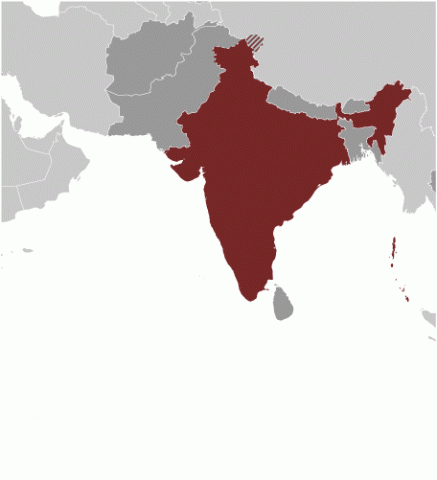Child Labor and Forced Labor Reports
India


Moderate Advancement
In 2023, India made moderate advancement in efforts to eliminate the worst forms of child labor. The government extended its Fast Track Special Courts, which expedite the trial process for sexual offense cases, including the commercial sexual exploitation of children. The Railway Protection Force and Government Railway Police rescued 858 children from railway platforms, preventing them from being exploited for labor exploitation or sex trafficking. Several states provided rehabilitation and financial assistance to 654 adult bonded labor survivors and their immediate families. However, despite these efforts, the government's existing hazardous work prohibitions do not include all occupations in which children work in unsafe and unhealthy environments, and penalties for illegally employing children are insufficient to deter violations. Prosecution rates for crimes related to the worst forms of child labor, including child trafficking, remain low and the mistreatment of child labor victims by the police remains a concern. Through the enhanced enforcement of the Foreign Contribution Regulation Act, the government continued to revoke the licenses of nongovernmental organizations and civil society organizations, some of which work to address the worst forms of child labor.
| Children | Age | Percent of Population |
|---|---|---|
| Working | 5 to 14 | 1.0% (2,119,846) |
| Hazardous Work by Children | 15 to 17 | Unavailable |
| Attending School | 5 to 14 | 90.7% |
| Combining Work and School | 7 to 14 | 0.4% |
| Sector/Industry | Activity |
|---|---|
| Agriculture | Producing hybrid cottonseed, cultivating cotton, harvesting and processing sugarcane, transplanting rice seedlings, and performing peripheral work on farms, such as removing weeds. |
| Industry | Manufacturing garments, weaving silk fabric and carpets,† producing raw silk thread (sericulture), spinning cotton thread and yarn, and embellishing textiles with silver and gold (zari).† Quarrying and breaking stone and sandstone,† producing bricks,† recovering metals from electronic waste (e-waste),† and mining and collecting mica.† Polishing gems† and manufacturing glass bangles,† locks,† and brassware.† Rolling cigarettes (bidis)† and manufacturing incense sticks (agarbatti), fireworks,† and matches.† Manufacturing footwear; producing leather goods and accessories,† and stitching soccer balls. |
| Services | Domestic work.† Working in restaurants, hotels, food service, and tourism services. Street work, including scavenging, sorting garbage, selling trinkets, and organized begging. Working in automobile workshops and repairing vehicles. |
| Categorical Worst Forms of Child Labor‡ | Forced labor in agriculture, including producing hybrid cottonseed, making bricks, quarrying stones, and in rice mills. Forced labor in garments, embroidering silver and gold into textiles (zari), domestic work, and begging. Commercial sexual exploitation, sometimes as a result of human trafficking. Recruitment of children by non-state armed groups for use in armed conflict. |
† Determined by national law or regulation as hazardous and, as such, relevant to Article 3(d) of ILO C. 182.
‡ Child labor understood as the worst forms of child labor per se under Article 3(a)–(c) of ILO C. 182.
Children at Higher Risk
In India, migrant children, low-caste children, and religious minorities are vulnerable to child labor, commercial sexual exploitation, and familial debt bondage. Girls from such disadvantaged communities are vulnerable to forced and bonded labor in the home-based garment sector. Caste-based discrimination and poverty renders Dalit children especially vulnerable to child labor. Children are vulnerable to labor exploitation in sectors in which adults from marginalized castes face labor exploitation, such as shrimp processing in Adhra Pradesh, where children reportedly accompany their families in debt bondage. In some cases, girls from the Dalit community are particularly vulnerable to exploitation. Furthermore, climate change in India is pushing more children into child labor as children drop out of school to help their parents make up livelihoods lost to extreme weather events. Maoist groups reportedly forcibly recruit children in Chhattisgarh and Jharkhand to handle weapons, serve as human shields, and for use as cooks, porters, and informants in armed conflict. Reports indicate that some non-state armed groups recruit girls for sexual exploitation, including practices indicative of sexual slavery.
Barriers to Education Access
In India, school budgetary constraints, inadequate transportation for children in rural areas, a lack of separate and sanitary washrooms for female students, and inadequate infrastructure in existing schools present barriers to education access. Limited direct recruitment for teaching jobs and a cumbersome teacher recruitment process has led to high pupil-teacher ratios, severe teacher vacancies, and a non-availability of teachers with subject matter expertise, adversely impacting quality of education. Lower-caste Hindu children, members of tribal communities, and religious minorities face discrimination and harassment by education officials. Lower-caste children in some schools are segregated from other students, given less food than higher-caste students, relegated to seats in the back of classrooms, and assigned tasks like cleaning toilets during the school day.
| Standard | Age | Meets International Standards | Legislation |
|---|---|---|---|
| Minimum Age for Work | 14 | ✓ | Section 3(1) of the Child and Adolescent Labor (Prohibition and Regulation) Amendment Act |
| Minimum Age for Hazardous Work | 18 | ✓ | Section 3A of the Child and Adolescent Labor (Prohibition and Regulation) Act |
| Identification of Hazardous Occupations or Activities Prohibited for Children | ✓ | Schedule to the Child and Adolescent Labor (Prohibition and Regulation) Act; The Occupational Safety, Health and Working Conditions Code | |
| Prohibition of Slavery, Debt Bondage, and Forced Labor | ✓ | Sections 2(g), 4, and 16–19 of the Bonded Labor System (Abolition) Act; Sections 138(4), 141, 143, and 144 of the Bharatiya Nyaya Sanhita; Section 79 of the Juvenile Justice (Care and Protection of Children) Act | |
| Prohibition of Child Trafficking | ✗ | Sections 139 and 141 of the Bharatiya Nyaya Sanhita; Sections 2, 5, 5A, and 5B of the Immoral Traffic (Prevention) Act; Article 23 of the Constitution | |
| Prohibition of Commercial Sexual Exploitation of Children | ✓ | Sections 93, 94, 96, 97, 139, and 142 of the Bharatiya Nyaya Sanhita; Sections 4–6 of the Immoral Traffic (Prevention) Act; Sections 13 and 14 of the Protection of Children from Sexual Offences Act; Section 67B of the Information Technology Act | |
| Prohibition of Using Children in Illicit Activities | ✓ | Sections 76, 78, and 83(2) of the Juvenile Justice (Care and Protection of Children) Act; Sections 15–18, 20–23, and 32B(c) of the Narcotic Drugs and Psychotropic Substance Act; Section 93 of the Bharatiya Nyaya Sanhita | |
| Minimum Age for Voluntary State Military Recruitment | 16 | ✓ | Codified Military Rules |
| Prohibition of Compulsory Recruitment of Children by (State) Military | N/A* | ||
| Prohibition of Military Recruitment by Non-state Armed Groups | ✓ | Section 1(2) and 83 of the Juvenile Justice (Care and Protection of Children) Act | |
| Compulsory Education Age | 14 | ✓ | Section 3 of the Right of Children to Free and Compulsory Education Act |
| Free Public Education | ✓ | Section 3 of the Right of Children to Free and Compulsory Education Act |
* Country has no conscription
India's new criminal code, the Bharatiya Nayaya Sanhita, went into effect in 2024. India's hazardous work regulations for children ages 14 to 18—established in the country's Occupational, Safety, Health, and Working Conditions (OSH) Code—do not include all sectors in which children are known to work, including spinning mills, garment production, and carpet making, which expose children to dangerous machinery and difficult working conditions, including long hours. The OSH Code has not been universally adopted at the state level and the deadline for state-level adoption remains unknown, rendering children in some states vulnerable to child labor. The OSH Code only applies to institutions with 10 or more employees, leaving workers in smaller workplaces unprotected. India's child trafficking laws do not meet international standards as they require the use of force, fraud, or coercion to establish child trafficking offenses. Although sources report that the minimum age for voluntary recruitment into India’s Armed Forces is age 16 and that individuals must be age 18 to be deployed, these legal provisions are not publicly available and could not be verified.
| Organization/Agency | Role & Activities |
|---|
| State Government Labor Ministries: Each state has its own labor ministry that employs labor inspectors responsible for the enforcement of labor laws. State ministries conduct labor inspections, including inspections for child labor, and assess penalties for violations. Ministries refer children to child welfare committees for protection and rehabilitation services when child workers are identified and removed from work. |
| Criminal Law Enforcement Agencies: Enforce laws pertaining to the worst forms of child labor. State and local police submit information to District Magistrates to determine whether a case should be prosecuted in District Court. Police refer children found in child labor situations to child welfare committees for protection and rehabilitation services. Anti-Human Trafficking Units, which are reportedly not fully operational or established in all states, function under district police headquarters and provide intelligence gathering on human trafficking cases. Cases that fall under the Protection of Children from Sexual Offences Act, including the commercial sexual exploitation of children, are referred to Fast Track Special Courts (FTSCs), which are mandated to prosecute offenders within 1 year. A backlog of cases and insufficient training of personnel, however, prevents the courts from complying with this timeline. Reportedly, some police do not follow protocol in child trafficking investigations and state authorities have ordered police to register these cases as kidnapping or missing persons cases to reduce the number of human trafficking cases in official statistics. |
| Overview of Enforcement Efforts | 2023 |
|---|---|
| Has a Labor Inspectorate | Yes |
| Able to Assess Civil Penalties | Yes |
| Routinely Conducted Worksite Inspections | Unknown |
| Unannounced Inspections Permitted | Yes |
| Has a Complaint Mechanism | Yes |
| Imposed Penalties for Child Labor Violations | Unknown |
| Conducted Criminal Investigations for Worst Forms of Child Labor Crimes | Yes |
| Imposed Penalties for Worst Forms of Child Labor Crimes | Unknown |
It is unknown how many labor inspectors conducted worksite inspections, or whether child labor violations were found. In addition, although investigations into suspected cases of the worst forms of child labor were conducted, the total number of investigations is unknown. However, the Government of India reported that 609 prosecutions were initiated, and 181 perpetrators—including cases pending from previous years—were convicted for suspected worst forms of child labor crimes.
| Coordinating Body | Role & Activities |
|---|
| Child Labor Coordinating Bodies: Led by the Ministry of Labor and Employment (MOLE), the Task Force to Implement the Child Labor Act (CLA) comprises 12 officials from the federal and state governments. In 2023, the task force met three times and instructed states to closely monitor child labor issues to ensure the implementation of the CLA. The Central Advisory Board on Child and Adolescent Labor monitors the implementation of existing legislation and programs related to child labor. The board met once during the reporting period; the outcome of the meeting, however, is unknown. In 2023, MOLE released a standard operating procedure to assign responsibilities to different government departments to tackle child labor and bonded labor concerns. |
| Policy | Description & Activities |
|---|
| National Policy on Child Labor: Overseen by MOLE and the Ministry of Women and Child Development. Aims to address child labor and includes activities for the provision of assistance to children. Under the policy, the Platform for Effective Enforcement for No Child Labor (PENCIL) Portal was developed and implemented. The PENCIL Portal incorporates a child tracking filing system to enhance enforcement of child labor laws, including the Child Labor Act, and provides a complaint mechanism for citizens to report child labor violations. Since 2017, The PENCIL portal has removed 144,021 children from child labor. |
| National Plan of Action for Children: Identifies priority actions for achieving the objectives set out in the National Policy for Children, including age-appropriate classes for children released from child labor and child trafficking. Also seeks to develop community-based prevention, identification and release procedures, victim services, and reintegration mechanisms, as well as strengthen institutions to address the worst forms of child labor. Research was unable to identify specific activities carried out under this policy during the reporting period. |
| State Action Plans on Child Labor: State- and union territory-specific plans to address and eliminate child labor. Exist in only 11 out of 28 states. In 2023, the Government of Odisha published actions undertaken to implement its Plan, which included child labor prevention trainings for employers, publishing data on inspections conducted under the Child and Adolescent Labor Act, and collaborative activities with NGOs. The Delhi government collaborated with local resident welfare associations to address child labor in the state's domestic sector. In addition, Bihar's State Child Labor Commission rescued 795 children from child labor through effective coordination and enforcement mechanisms. States do not uniformly report on actions undertaken to implement action plans. |
| Program | Description & Activities |
|---|
| National Child Labor Project (NCLP) Scheme and Special Training Centers (STCs):† MOLE program operating at the district level to identify working children, remove them from work, and provide them with education and vocational training. Comprises approximately 3,000 NCLP STCs that provide children with support including stipends, meals, and health checkups. From April 2022 to March 2023, the NCLP STC program removed 13,761 children from child labor and provided services to victims. Observers note that since the merging of the NCLP with the Samagara Shiksha Abhiyan scheme—a program focused on achieving universal elementary education—many children have re-entered the labor market as local schools cannot accommodate all released children and do not provide the services that former child laborers require. |
| Central Sector Scheme for Rehabilitation of Bonded Laborers:† MOLE program that provides released bonded laborers with financial assistance and social protection services, and funds district-level surveys on bonded labor prevalence. In 2022–2023, Rajasthan, Uttar Pradesh, and Tamil Nadu cumulatively provided rehabilitation assistance to 654 survivors. Although reporting did not indicate how many of these survivors were children, intergenerational debt bondage is common in India—thus, removing parents from bonded labor likely protects their children from bonded labor as well. Research did not yield information on the remainder of the states' efforts to rehabilitate bonded labor survivors. Some state governments lack standard operating procedures to implement this scheme and failed to issue release certificates, and some failed to provide adequate financial assistance to bonded labor victims without significant support from NGOs. |
| Anti-Human Trafficking Activities:† Government-operated anti-trafficking shelters, run in collaboration with NGOs and state governments. Shelters include government-run juvenile justice homes and government-run women and children's homes. The Ministry of Women and Child Development-funded Ujjawala and Swadhar Greh schemes provide services to and repatriate human trafficking survivors, including children. In 2023, the Ujjawala and Swadhar Greh schemes merged to create the Shakti Sadan scheme, an integrated relief and services program. The scheme provides shelter, food, clothing, and primary health for female and child victims of human trafficking. Although government-supported shelters were active during the reporting period, observers reported that the shelters have not received adequate funding in over 2 years, and many operated at a deficit in 2023. |
For information about USDOL’s projects to address child labor around the world, visit https://www.dol.gov/agencies/ilab/ilab-project-page-search
† Program is funded by the Government of India.
| Area | Suggested Action |
|---|---|
| Legal Framework | Include in the list of hazardous work prohibited for all children all sectors in which children work in unsafe and unhealthy conditions, such as spinning mills, garment production, carpet making, and domestic work. |
| Amend child trafficking laws so they do not require threats, the use of force, or coercion to be established for the crime of child trafficking. | |
| Publish the legal instrument that establishes the minimum age for voluntary recruitment into India's armed forces. | |
| Encourage all states and union territories to enact rules to implement the Occupational, Safety, Health, and Working Conditions Code to ensure protection of children from hazardous forms of work. | |
| Enforcement | Employ at least 35,668 labor inspectors to ensure adequate coverage of the labor force of approximately 535 million people, and publish national data related to labor law enforcement. |
| Provide adequate training to labor inspectors and criminal investigators on child labor in all states and union territories, including on the new Occupational, Safety, Health, and Working Conditions Code. | |
| Fast track bonded labor cases and consistently impose penalties for violations. | |
| Provide states and union territories with dedicated and sufficient funding, staff, and infrastructure to establish anti-human trafficking units. | |
| Ensure that all cases under the Protection of Children from Sexual Offences Act and Fast Track Special Courts adhere to their mandated 1-year timeline for prosecution, that backlogs of Protection of Children from Sexual Offences cases are adjudicated with priority, and that judges and prosecutors at these courts are adequately trained to handle child sex crimes. | |
| Hold accountable public officials who facilitate, participate in, or hinder efforts to address the worst forms of child labor, including officials who accept bribes, hold children in bonded labor in agriculture and in brick kilns, and who delay registering human trafficking cases or mistreat human trafficking survivors. | |
| Prosecute and hold accountable perpetrators of the Jogini system to protect girls from lower castes from being sold to local deities for sexual exploitation in return for in-kind payments or cash allowances. | |
| Government Policies | Ensure that activities are undertaken to implement the National Plan of Action for Children and State Action Plans on Child Labor and publish results from activities undertaken to implement these plans annually. |
| Encourage states and territories that do not currently have action plans for the elimination of child labor to establish such plans. | |
| Social Programs | Reduce barriers and promote access to education for all children, including for low-caste Hindus, members of tribal communities, religious minorities, and other disadvantaged communities by providing sufficient training for teachers, providing separate and sanitary washrooms for girls, and increasing the number of available schools, especially in urban slums in which inadequate infrastructure options limit access to education. |
| Collect and make available to the public data on exploitative child labor in every state, including findings from district-level bonded labor surveys and raw data from the national census. | |
| Ensure that state governments issue release certificates and provide financial assistance for bonded labor victims, including full compensation for those freed from bonded labor, through the Central Sector Scheme for Rehabilitation of Bonded Laborers. | |
| Provide rescued child labor victims with adequate social services to prevent their re-entry to the labor market, including through educational re-entry programs. | |
| Ensure that the Foreign Contribution Regulation Act is not used to prevent child labor-focused nongovernmental organizations from obtaining international funding or preserving their licenses to operate in the country. | |
| Provide all states and union territories with funding for human trafficking shelters in a timely and consistent manner. | |
| Develop and implement social programs to address child labor, bonded child labor, and child trafficking among vulnerable populations in India, including religious minorities and migrant children. |
In India, workers face obstacles forming and maintaining unions. These obstacles include provisions requiring at least 100 workers or 10 percent of the workforce (whichever is lower) is represented in the union; a lack of collective bargaining rights for civil servants; the illegality of strikes in Kerala; and the illegality of strikes regarding essential services in Tamil Nadu.
your hand? Download ILAB's Sweat & Toil App today!


































